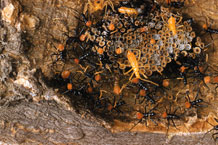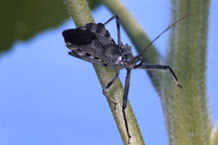home | fall garden | newcomer school garden
Assassin Bug
Many assassin bug species attack quickly and paralyze their prey, hence their name. Assassin bugs kill many garden pests including flies, mosquitoes, Japanese beetles and large caterpillars. They lie in wait for these insects, stab the prey with their proboscis (beak), and inject a toxin that dissolves the insect. The assassin bug then sucks out the other insect's liquefied tissue. They have been known to bite humans if disturbed. Their bite is very painful and can cause a severe reaction. There are over 5,000 species world-wide and about 40 species in Missouri. One assassin bug that lives in Missouri is the wheel bug. Its name comes from the cog-like crest found on its back. They are large insects measuring up to 1 1/2 inches in length, but are rarely seen because of their camouflage. Adult wheel bugs are gray to brownish-gray in color and have one of the most developed set of mouth parts among true bugs. In the fall, female wheel bugs will lay 40 to 200 small, brown cylindrical eggs on a tree twig. The following spring, eggs hatch into small nymphs. Nymphs, which do not have the wheel-shaped structure, have bright red or orange abdomens. They will undergo five molts until they reach adult stage the following summer. Since most of their prey are pests, wheel bugs are considered beneficial insects.
 |
 |
 |
